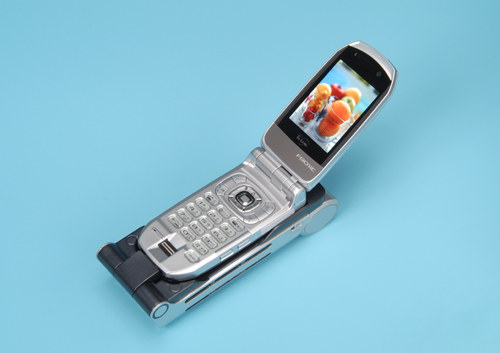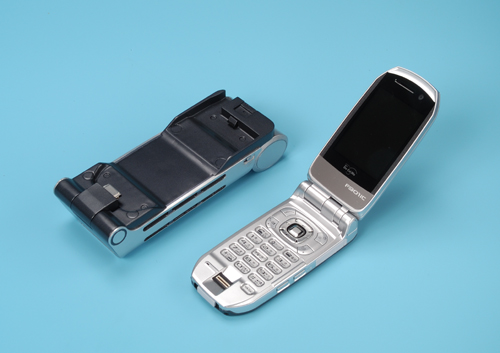Tokyo, July 06, 2005
Fujitsu Laboratories Ltd. today announced its co-development with NTT DoCoMo of a prototype high-capacity micro fuel cell(1) and the prototype development of an external recharger for FOMA handsets. For the prototype micro fuel cell device, the concentration of the methanol fuel used was raised from 30%, the concentration used for the companies' previous fuel cells, to a remarkably higher concentration of over 99%. This enables the prototype device to charge up to three FOMA handset batteries with just 18 cc of methanol.
The jointly developed fuel cell prototype will be exhibited at the DoCoMo booth at Wireless Japan 2005 to be held from July 13 to 15, and at the Environment corner at Fujitsu Forum 2005 from July 14 to 15, both in Tokyo.
Development Background
The R&D of micro fuel cells with replaceable fuel cartridges is being conducted, with the purpose of extending the operation time of mobile devices such as mobile phones.
In comparison with conventional lithium ion batteries, micro fuel cells offer theoretical performance that is ten-fold, and are capable of high-density storage of energy at practical performance levels three times greater.
In addition, since micro fuel cells can use methanol derived from biomass resources, there is anticipation that they will help reduce burden on the environment.
The performance of micro fuel cells depends on how compact they can be made and how much energy can be created from a given volume of fuel. Higher-capacity micro fuel cells will significantly improve user convenience, such as by increasing the number of times recharging is possible with a single cartridge.
Technological Challenges
Since micro fuel cells that employ methanol produce energy through the reaction between methanol and oxygen present in the air, power capacity can be increased by raising the concentration of the methanol solution. However, for passive type fuel cells(2) that are suited for miniaturization and lighter weight, a phenomenon known as "methanol crossover" occurrs, which is a fuel permeation that occurs between battery electrodes when high-concentration fuel is used directly with passive fuel cells, thereby resulting in lower generation efficiency.
Newly Developed Technology
Fujitsu developed new technology that makes it possible to use high-concentration methanol with concentration of over 99% for a passive micro fuel cell. By developing and employing a new material that reduces the methanol crossover effect by half compared to Fujitsu previous materials and to one-twentieth that of other commercially available materials, and by using the water by-product which appears during power generation to dilute the fuel, Fujitsu succeeded in effectively limiting the decline of power generation efficiency when using high-concentration fuel. Fujitsu and DoCoMo employed the new technology to co-develop an operable FOMA handset charger prototype.
Results
Using the newly developed technology, the cradle(3)-type passive micro fuel cell achieved a world record high-power output average of approximately 1 watt with methanol fuel of over 99% concentration.
Fujitsu also verified that the prototype FOMA handset recharger using the micro fuel cell can charge up to three lithium ion power batteries embedded in a FOMA handset, with a single cartridge with 18 cc of methanol fuel.
In comparison to previous fuel cells from Fujitsu and DoCoMo which use methanol at 30% concentration, the prototype recharger using the new micro fuel cell enables up to three times the power output time with a single 18 cc methanol fuel cartridge.
Future Developments
Through the development of high-performance materials, Fujitsu will continue to develop micro fuel cells that are more compact and operable over longer periods of time.
Prototype Fuel Cell: Main Specifications
Prototype FOMA handset charger key specifications
| Size |
150 x 56 x 19 mm |
| Weight |
190 g |
| Fuel used |
Methanol, concentration over 99% |
| Cartridge capacity |
18 cc, 12 cc |
| Generating capacity |
Maximum 9 watts |
| Handset interface |
Cradle |
| Charging specifications |
Maximum 5.4 volts (V), 700 milli-ampers (mA) |
 Figure 1. Prototype micro fuel cell recharger shown charging FOMA handset
Figure 1. Prototype micro fuel cell recharger shown charging FOMA handset
 Figure 2. Prototype micro fuel cell recharger and FOMA handset shown separately(4)
Figure 2. Prototype micro fuel cell recharger and FOMA handset shown separately(4)
![]() E-mail: mfc_staff1@ml.labs.fujitsu.com
E-mail: mfc_staff1@ml.labs.fujitsu.com![]() E-mail: mfc_staff1@ml.labs.fujitsu.com
E-mail: mfc_staff1@ml.labs.fujitsu.com
